Strategic Management of Hell Pizza: An In-Depth Business Report
VerifiedAdded on 2021/06/16
|9
|2799
|26
Report
AI Summary
This report provides a comprehensive analysis of Hell Pizza's strategic management, examining various aspects of its business operations. It begins with an introduction to the company and its origins, followed by an examination of its organizational culture, highlighting its multicultural workforce and ethical considerations. The report then delves into the frameworks used in the strategic management process, including stakeholder management and business networks, and identifies the factors contributing to the company's sustainable competitive advantage, such as group dynamics theory and competitive analysis. The role of HR policies in meeting organizational goals is also discussed. The report highlights the company's innovative marketing strategies, such as their pizza roulette and wild pizza range, and emphasizes the importance of employee communication and engagement. The analysis concludes by summarizing the key factors that have contributed to Hell Pizza's success, emphasizing their innovative business framework and care for their employees.
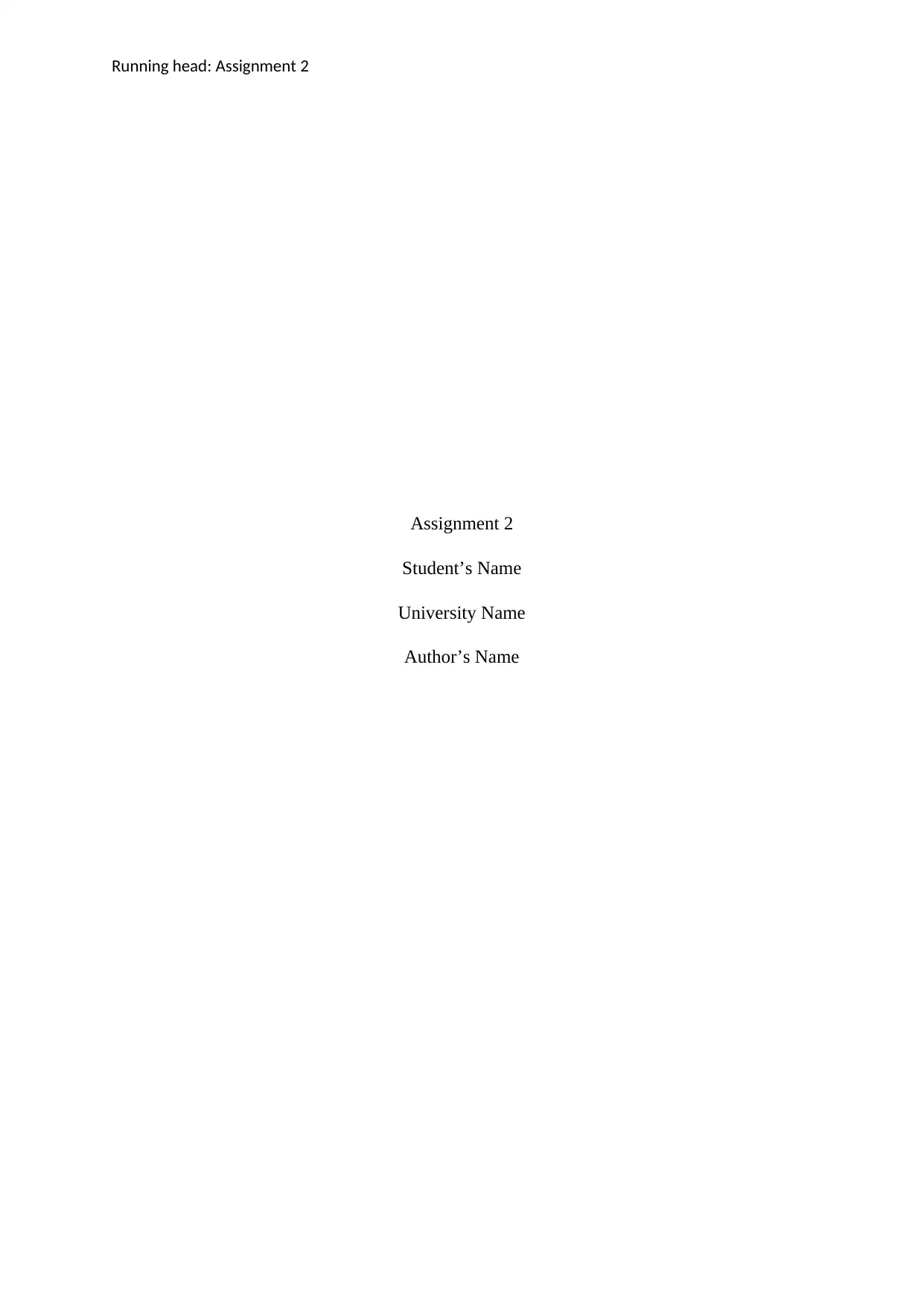
Running head: Assignment 2
Assignment 2
Student’s Name
University Name
Author’s Name
Assignment 2
Student’s Name
University Name
Author’s Name
Paraphrase This Document
Need a fresh take? Get an instant paraphrase of this document with our AI Paraphraser
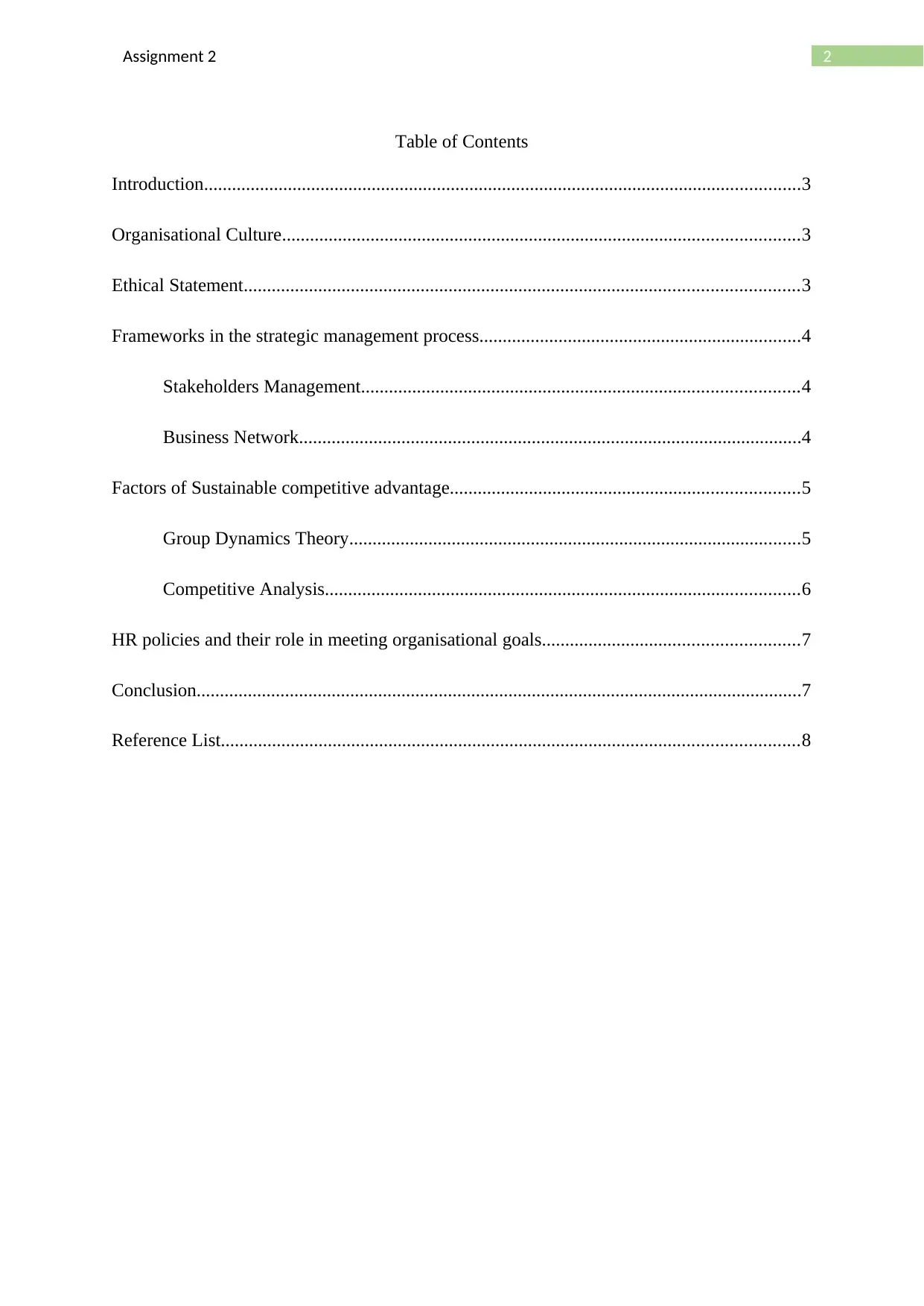
2Assignment 2
Table of Contents
Introduction................................................................................................................................3
Organisational Culture...............................................................................................................3
Ethical Statement.......................................................................................................................3
Frameworks in the strategic management process.....................................................................4
Stakeholders Management..............................................................................................4
Business Network............................................................................................................4
Factors of Sustainable competitive advantage...........................................................................5
Group Dynamics Theory.................................................................................................5
Competitive Analysis......................................................................................................6
HR policies and their role in meeting organisational goals.......................................................7
Conclusion..................................................................................................................................7
Reference List............................................................................................................................8
Table of Contents
Introduction................................................................................................................................3
Organisational Culture...............................................................................................................3
Ethical Statement.......................................................................................................................3
Frameworks in the strategic management process.....................................................................4
Stakeholders Management..............................................................................................4
Business Network............................................................................................................4
Factors of Sustainable competitive advantage...........................................................................5
Group Dynamics Theory.................................................................................................5
Competitive Analysis......................................................................................................6
HR policies and their role in meeting organisational goals.......................................................7
Conclusion..................................................................................................................................7
Reference List............................................................................................................................8

3Assignment 2
Introduction
In this assignment, the strategic management of one of the peering pizza companies of New
Zealand, Hell Pizza have been discussed. The organisation started as an innovation of two co-
founders. However the aid of strategic business planning combined with a full proof business
policy helped them to achieve the standard of a brand. In this assignment various issues that
the company faced have been identified. Starting from the controversies of the advertisement
campaigns to the sell out to Tasman Pacific Company, various issues have impacted the
business of Hell Pizza. However, in spite of all these a subtle organisational; structure and
good stakeholder communication strategy have helped them to remain integrated in the face
of all odds. The business approach that helped the company to reach the zenith of success
have been described in detail in this project.
Organisational Culture
As a traditional counterpart of native business organisations of New Zealand, Hell Pizza
operates their stores in multicultural groups. An instance might be provided. In a particular
Hell Pizza outlet in Wellington, among 125 employees, only 6 are New Zealanders
(hellpizza.com, 2018). The rest are ethically Chinese, Vietnamese or Japanese. However, the
Asian workers all belong to sound academic backgrounds, whereas the locals are basically
high school pass outs. In this scenario, the demographic contrast and clash is inevitable
(Albrecht et al. 2015). The Asian employees have an outlook of taking the business to a new
level. While the local employees have a perception that they have more knowledge of the
local market and are knowledgeable about the customer base in New Zealand.
Ethical Statement
Effective franchising has been the protagonist behind the success of the HELL entrepreneurs
Stu and Callam. Their business ethics have paved the way for the immense success of HEL
pizza as an SME. The basic policy that the founder directors of the company have maintained
throughout the business timeline are hard work, individual care to the customers and
addressing big and small needs and issues of the employees. Having fun at work and staying
loyal to the customers have been the two basic ethical considerations for HELL pizza that
have led them to success.
Introduction
In this assignment, the strategic management of one of the peering pizza companies of New
Zealand, Hell Pizza have been discussed. The organisation started as an innovation of two co-
founders. However the aid of strategic business planning combined with a full proof business
policy helped them to achieve the standard of a brand. In this assignment various issues that
the company faced have been identified. Starting from the controversies of the advertisement
campaigns to the sell out to Tasman Pacific Company, various issues have impacted the
business of Hell Pizza. However, in spite of all these a subtle organisational; structure and
good stakeholder communication strategy have helped them to remain integrated in the face
of all odds. The business approach that helped the company to reach the zenith of success
have been described in detail in this project.
Organisational Culture
As a traditional counterpart of native business organisations of New Zealand, Hell Pizza
operates their stores in multicultural groups. An instance might be provided. In a particular
Hell Pizza outlet in Wellington, among 125 employees, only 6 are New Zealanders
(hellpizza.com, 2018). The rest are ethically Chinese, Vietnamese or Japanese. However, the
Asian workers all belong to sound academic backgrounds, whereas the locals are basically
high school pass outs. In this scenario, the demographic contrast and clash is inevitable
(Albrecht et al. 2015). The Asian employees have an outlook of taking the business to a new
level. While the local employees have a perception that they have more knowledge of the
local market and are knowledgeable about the customer base in New Zealand.
Ethical Statement
Effective franchising has been the protagonist behind the success of the HELL entrepreneurs
Stu and Callam. Their business ethics have paved the way for the immense success of HEL
pizza as an SME. The basic policy that the founder directors of the company have maintained
throughout the business timeline are hard work, individual care to the customers and
addressing big and small needs and issues of the employees. Having fun at work and staying
loyal to the customers have been the two basic ethical considerations for HELL pizza that
have led them to success.
⊘ This is a preview!⊘
Do you want full access?
Subscribe today to unlock all pages.

Trusted by 1+ million students worldwide
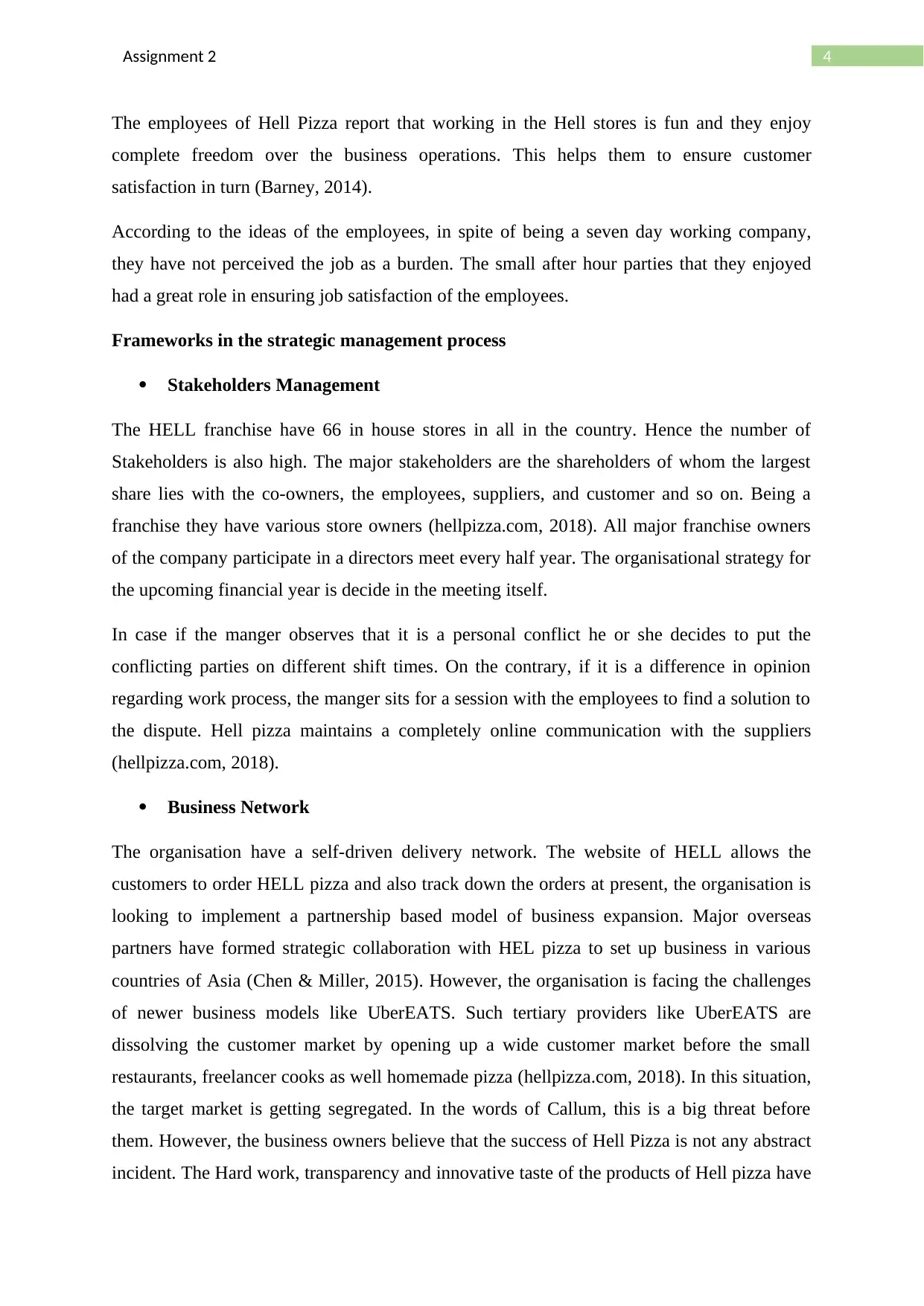
4Assignment 2
The employees of Hell Pizza report that working in the Hell stores is fun and they enjoy
complete freedom over the business operations. This helps them to ensure customer
satisfaction in turn (Barney, 2014).
According to the ideas of the employees, in spite of being a seven day working company,
they have not perceived the job as a burden. The small after hour parties that they enjoyed
had a great role in ensuring job satisfaction of the employees.
Frameworks in the strategic management process
Stakeholders Management
The HELL franchise have 66 in house stores in all in the country. Hence the number of
Stakeholders is also high. The major stakeholders are the shareholders of whom the largest
share lies with the co-owners, the employees, suppliers, and customer and so on. Being a
franchise they have various store owners (hellpizza.com, 2018). All major franchise owners
of the company participate in a directors meet every half year. The organisational strategy for
the upcoming financial year is decide in the meeting itself.
In case if the manger observes that it is a personal conflict he or she decides to put the
conflicting parties on different shift times. On the contrary, if it is a difference in opinion
regarding work process, the manger sits for a session with the employees to find a solution to
the dispute. Hell pizza maintains a completely online communication with the suppliers
(hellpizza.com, 2018).
Business Network
The organisation have a self-driven delivery network. The website of HELL allows the
customers to order HELL pizza and also track down the orders at present, the organisation is
looking to implement a partnership based model of business expansion. Major overseas
partners have formed strategic collaboration with HEL pizza to set up business in various
countries of Asia (Chen & Miller, 2015). However, the organisation is facing the challenges
of newer business models like UberEATS. Such tertiary providers like UberEATS are
dissolving the customer market by opening up a wide customer market before the small
restaurants, freelancer cooks as well homemade pizza (hellpizza.com, 2018). In this situation,
the target market is getting segregated. In the words of Callum, this is a big threat before
them. However, the business owners believe that the success of Hell Pizza is not any abstract
incident. The Hard work, transparency and innovative taste of the products of Hell pizza have
The employees of Hell Pizza report that working in the Hell stores is fun and they enjoy
complete freedom over the business operations. This helps them to ensure customer
satisfaction in turn (Barney, 2014).
According to the ideas of the employees, in spite of being a seven day working company,
they have not perceived the job as a burden. The small after hour parties that they enjoyed
had a great role in ensuring job satisfaction of the employees.
Frameworks in the strategic management process
Stakeholders Management
The HELL franchise have 66 in house stores in all in the country. Hence the number of
Stakeholders is also high. The major stakeholders are the shareholders of whom the largest
share lies with the co-owners, the employees, suppliers, and customer and so on. Being a
franchise they have various store owners (hellpizza.com, 2018). All major franchise owners
of the company participate in a directors meet every half year. The organisational strategy for
the upcoming financial year is decide in the meeting itself.
In case if the manger observes that it is a personal conflict he or she decides to put the
conflicting parties on different shift times. On the contrary, if it is a difference in opinion
regarding work process, the manger sits for a session with the employees to find a solution to
the dispute. Hell pizza maintains a completely online communication with the suppliers
(hellpizza.com, 2018).
Business Network
The organisation have a self-driven delivery network. The website of HELL allows the
customers to order HELL pizza and also track down the orders at present, the organisation is
looking to implement a partnership based model of business expansion. Major overseas
partners have formed strategic collaboration with HEL pizza to set up business in various
countries of Asia (Chen & Miller, 2015). However, the organisation is facing the challenges
of newer business models like UberEATS. Such tertiary providers like UberEATS are
dissolving the customer market by opening up a wide customer market before the small
restaurants, freelancer cooks as well homemade pizza (hellpizza.com, 2018). In this situation,
the target market is getting segregated. In the words of Callum, this is a big threat before
them. However, the business owners believe that the success of Hell Pizza is not any abstract
incident. The Hard work, transparency and innovative taste of the products of Hell pizza have
Paraphrase This Document
Need a fresh take? Get an instant paraphrase of this document with our AI Paraphraser
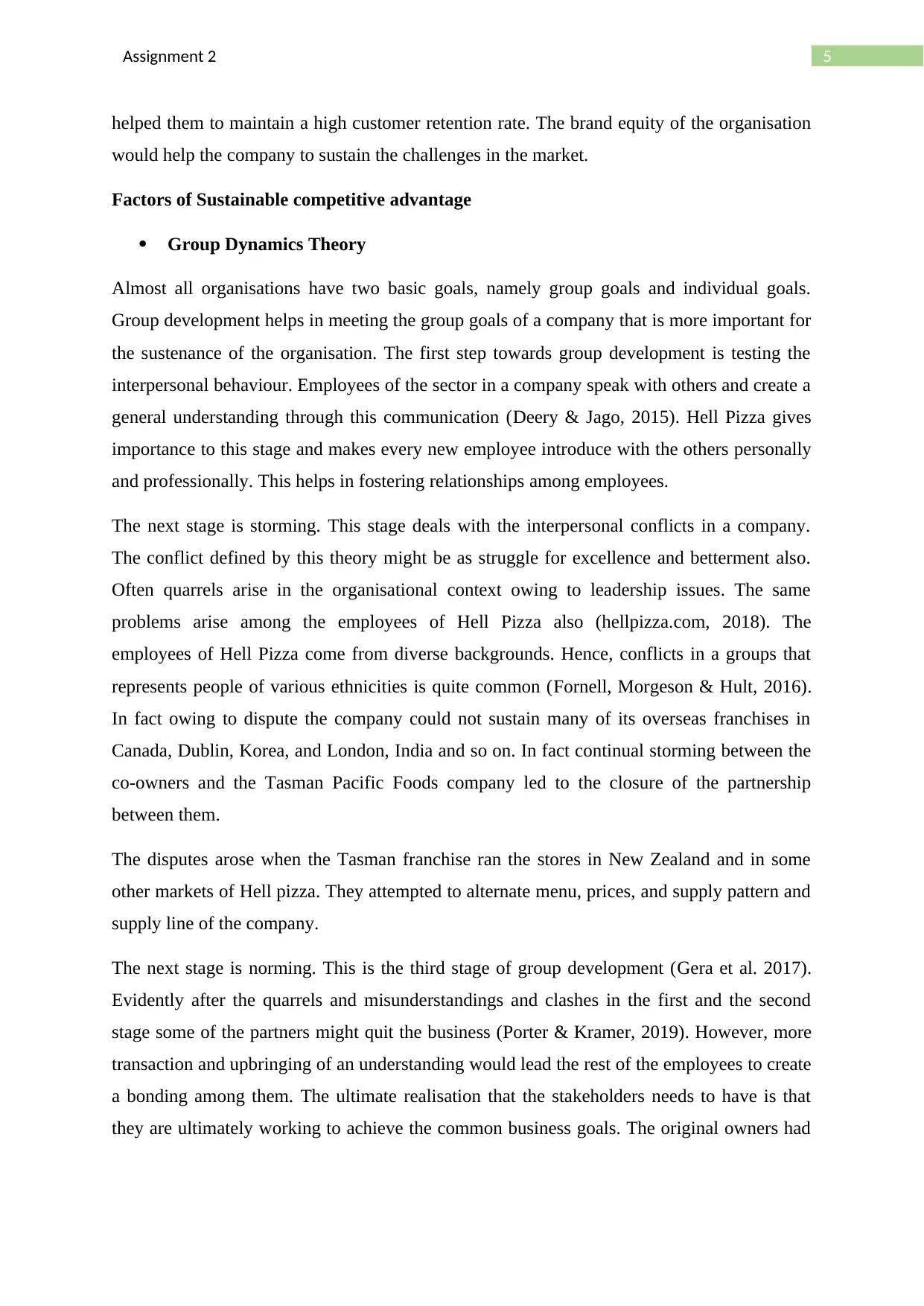
5Assignment 2
helped them to maintain a high customer retention rate. The brand equity of the organisation
would help the company to sustain the challenges in the market.
Factors of Sustainable competitive advantage
Group Dynamics Theory
Almost all organisations have two basic goals, namely group goals and individual goals.
Group development helps in meeting the group goals of a company that is more important for
the sustenance of the organisation. The first step towards group development is testing the
interpersonal behaviour. Employees of the sector in a company speak with others and create a
general understanding through this communication (Deery & Jago, 2015). Hell Pizza gives
importance to this stage and makes every new employee introduce with the others personally
and professionally. This helps in fostering relationships among employees.
The next stage is storming. This stage deals with the interpersonal conflicts in a company.
The conflict defined by this theory might be as struggle for excellence and betterment also.
Often quarrels arise in the organisational context owing to leadership issues. The same
problems arise among the employees of Hell Pizza also (hellpizza.com, 2018). The
employees of Hell Pizza come from diverse backgrounds. Hence, conflicts in a groups that
represents people of various ethnicities is quite common (Fornell, Morgeson & Hult, 2016).
In fact owing to dispute the company could not sustain many of its overseas franchises in
Canada, Dublin, Korea, and London, India and so on. In fact continual storming between the
co-owners and the Tasman Pacific Foods company led to the closure of the partnership
between them.
The disputes arose when the Tasman franchise ran the stores in New Zealand and in some
other markets of Hell pizza. They attempted to alternate menu, prices, and supply pattern and
supply line of the company.
The next stage is norming. This is the third stage of group development (Gera et al. 2017).
Evidently after the quarrels and misunderstandings and clashes in the first and the second
stage some of the partners might quit the business (Porter & Kramer, 2019). However, more
transaction and upbringing of an understanding would lead the rest of the employees to create
a bonding among them. The ultimate realisation that the stakeholders needs to have is that
they are ultimately working to achieve the common business goals. The original owners had
helped them to maintain a high customer retention rate. The brand equity of the organisation
would help the company to sustain the challenges in the market.
Factors of Sustainable competitive advantage
Group Dynamics Theory
Almost all organisations have two basic goals, namely group goals and individual goals.
Group development helps in meeting the group goals of a company that is more important for
the sustenance of the organisation. The first step towards group development is testing the
interpersonal behaviour. Employees of the sector in a company speak with others and create a
general understanding through this communication (Deery & Jago, 2015). Hell Pizza gives
importance to this stage and makes every new employee introduce with the others personally
and professionally. This helps in fostering relationships among employees.
The next stage is storming. This stage deals with the interpersonal conflicts in a company.
The conflict defined by this theory might be as struggle for excellence and betterment also.
Often quarrels arise in the organisational context owing to leadership issues. The same
problems arise among the employees of Hell Pizza also (hellpizza.com, 2018). The
employees of Hell Pizza come from diverse backgrounds. Hence, conflicts in a groups that
represents people of various ethnicities is quite common (Fornell, Morgeson & Hult, 2016).
In fact owing to dispute the company could not sustain many of its overseas franchises in
Canada, Dublin, Korea, and London, India and so on. In fact continual storming between the
co-owners and the Tasman Pacific Foods company led to the closure of the partnership
between them.
The disputes arose when the Tasman franchise ran the stores in New Zealand and in some
other markets of Hell pizza. They attempted to alternate menu, prices, and supply pattern and
supply line of the company.
The next stage is norming. This is the third stage of group development (Gera et al. 2017).
Evidently after the quarrels and misunderstandings and clashes in the first and the second
stage some of the partners might quit the business (Porter & Kramer, 2019). However, more
transaction and upbringing of an understanding would lead the rest of the employees to create
a bonding among them. The ultimate realisation that the stakeholders needs to have is that
they are ultimately working to achieve the common business goals. The original owners had
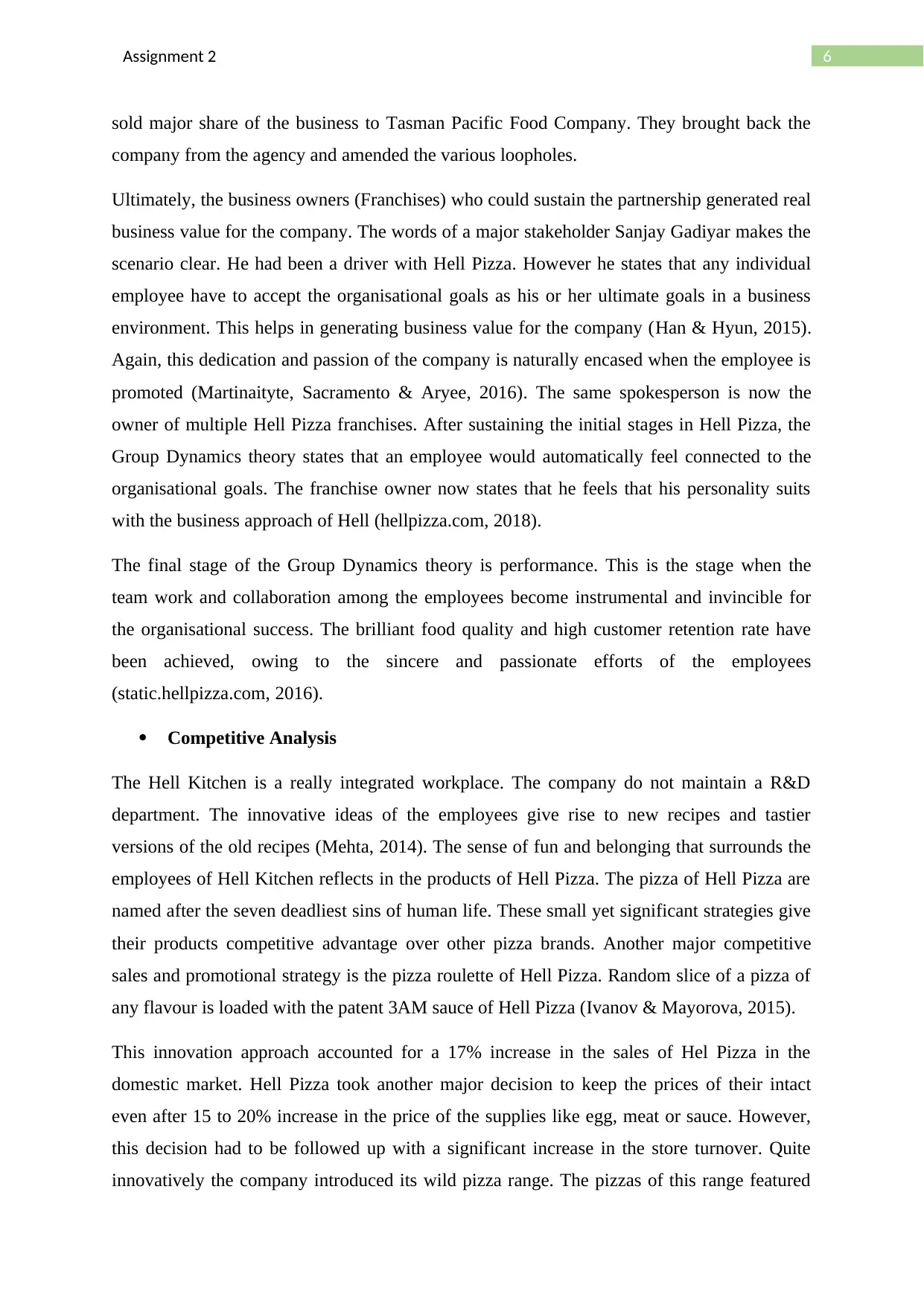
6Assignment 2
sold major share of the business to Tasman Pacific Food Company. They brought back the
company from the agency and amended the various loopholes.
Ultimately, the business owners (Franchises) who could sustain the partnership generated real
business value for the company. The words of a major stakeholder Sanjay Gadiyar makes the
scenario clear. He had been a driver with Hell Pizza. However he states that any individual
employee have to accept the organisational goals as his or her ultimate goals in a business
environment. This helps in generating business value for the company (Han & Hyun, 2015).
Again, this dedication and passion of the company is naturally encased when the employee is
promoted (Martinaityte, Sacramento & Aryee, 2016). The same spokesperson is now the
owner of multiple Hell Pizza franchises. After sustaining the initial stages in Hell Pizza, the
Group Dynamics theory states that an employee would automatically feel connected to the
organisational goals. The franchise owner now states that he feels that his personality suits
with the business approach of Hell (hellpizza.com, 2018).
The final stage of the Group Dynamics theory is performance. This is the stage when the
team work and collaboration among the employees become instrumental and invincible for
the organisational success. The brilliant food quality and high customer retention rate have
been achieved, owing to the sincere and passionate efforts of the employees
(static.hellpizza.com, 2016).
Competitive Analysis
The Hell Kitchen is a really integrated workplace. The company do not maintain a R&D
department. The innovative ideas of the employees give rise to new recipes and tastier
versions of the old recipes (Mehta, 2014). The sense of fun and belonging that surrounds the
employees of Hell Kitchen reflects in the products of Hell Pizza. The pizza of Hell Pizza are
named after the seven deadliest sins of human life. These small yet significant strategies give
their products competitive advantage over other pizza brands. Another major competitive
sales and promotional strategy is the pizza roulette of Hell Pizza. Random slice of a pizza of
any flavour is loaded with the patent 3AM sauce of Hell Pizza (Ivanov & Mayorova, 2015).
This innovation approach accounted for a 17% increase in the sales of Hel Pizza in the
domestic market. Hell Pizza took another major decision to keep the prices of their intact
even after 15 to 20% increase in the price of the supplies like egg, meat or sauce. However,
this decision had to be followed up with a significant increase in the store turnover. Quite
innovatively the company introduced its wild pizza range. The pizzas of this range featured
sold major share of the business to Tasman Pacific Food Company. They brought back the
company from the agency and amended the various loopholes.
Ultimately, the business owners (Franchises) who could sustain the partnership generated real
business value for the company. The words of a major stakeholder Sanjay Gadiyar makes the
scenario clear. He had been a driver with Hell Pizza. However he states that any individual
employee have to accept the organisational goals as his or her ultimate goals in a business
environment. This helps in generating business value for the company (Han & Hyun, 2015).
Again, this dedication and passion of the company is naturally encased when the employee is
promoted (Martinaityte, Sacramento & Aryee, 2016). The same spokesperson is now the
owner of multiple Hell Pizza franchises. After sustaining the initial stages in Hell Pizza, the
Group Dynamics theory states that an employee would automatically feel connected to the
organisational goals. The franchise owner now states that he feels that his personality suits
with the business approach of Hell (hellpizza.com, 2018).
The final stage of the Group Dynamics theory is performance. This is the stage when the
team work and collaboration among the employees become instrumental and invincible for
the organisational success. The brilliant food quality and high customer retention rate have
been achieved, owing to the sincere and passionate efforts of the employees
(static.hellpizza.com, 2016).
Competitive Analysis
The Hell Kitchen is a really integrated workplace. The company do not maintain a R&D
department. The innovative ideas of the employees give rise to new recipes and tastier
versions of the old recipes (Mehta, 2014). The sense of fun and belonging that surrounds the
employees of Hell Kitchen reflects in the products of Hell Pizza. The pizza of Hell Pizza are
named after the seven deadliest sins of human life. These small yet significant strategies give
their products competitive advantage over other pizza brands. Another major competitive
sales and promotional strategy is the pizza roulette of Hell Pizza. Random slice of a pizza of
any flavour is loaded with the patent 3AM sauce of Hell Pizza (Ivanov & Mayorova, 2015).
This innovation approach accounted for a 17% increase in the sales of Hel Pizza in the
domestic market. Hell Pizza took another major decision to keep the prices of their intact
even after 15 to 20% increase in the price of the supplies like egg, meat or sauce. However,
this decision had to be followed up with a significant increase in the store turnover. Quite
innovatively the company introduced its wild pizza range. The pizzas of this range featured
⊘ This is a preview!⊘
Do you want full access?
Subscribe today to unlock all pages.

Trusted by 1+ million students worldwide
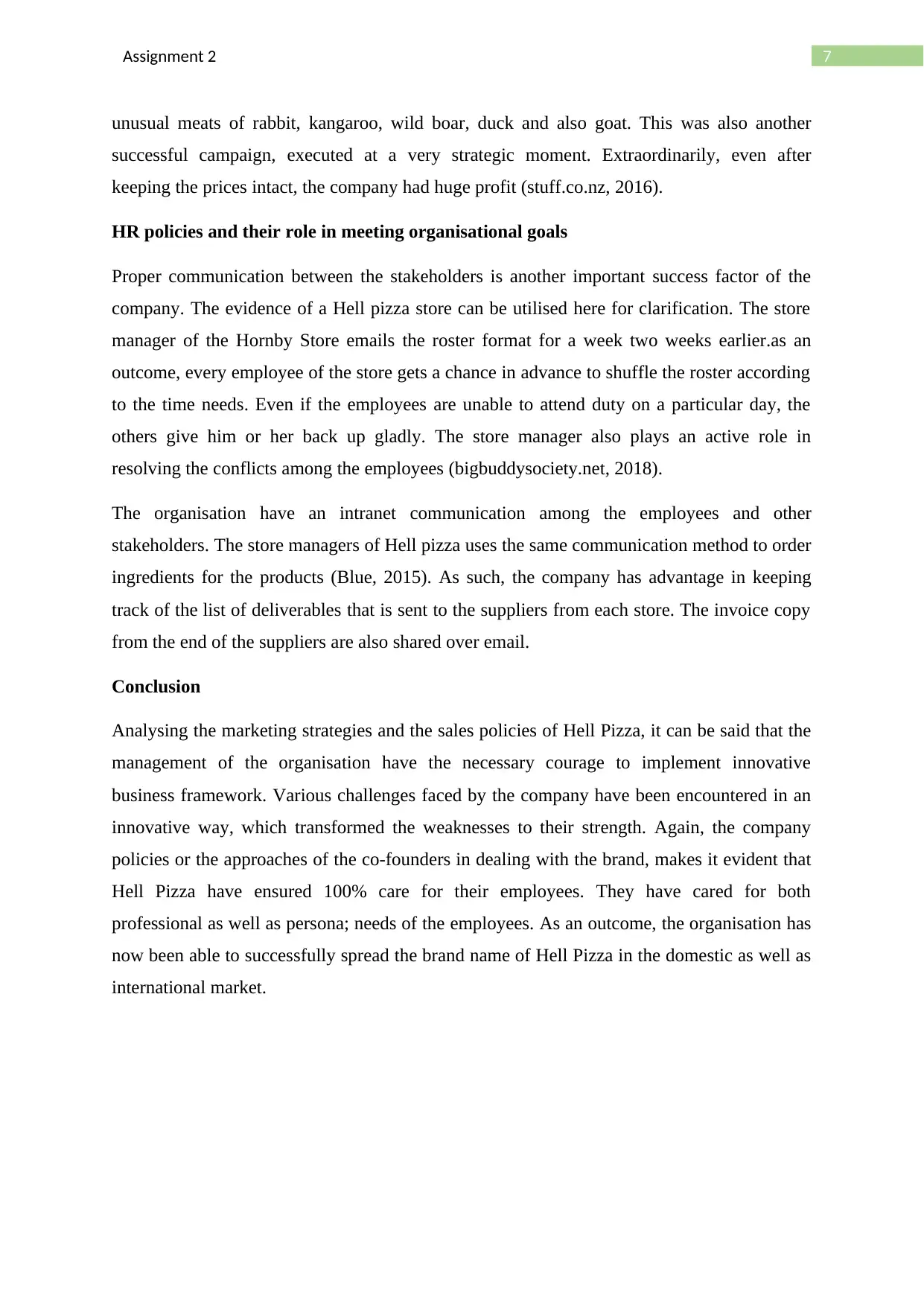
7Assignment 2
unusual meats of rabbit, kangaroo, wild boar, duck and also goat. This was also another
successful campaign, executed at a very strategic moment. Extraordinarily, even after
keeping the prices intact, the company had huge profit (stuff.co.nz, 2016).
HR policies and their role in meeting organisational goals
Proper communication between the stakeholders is another important success factor of the
company. The evidence of a Hell pizza store can be utilised here for clarification. The store
manager of the Hornby Store emails the roster format for a week two weeks earlier.as an
outcome, every employee of the store gets a chance in advance to shuffle the roster according
to the time needs. Even if the employees are unable to attend duty on a particular day, the
others give him or her back up gladly. The store manager also plays an active role in
resolving the conflicts among the employees (bigbuddysociety.net, 2018).
The organisation have an intranet communication among the employees and other
stakeholders. The store managers of Hell pizza uses the same communication method to order
ingredients for the products (Blue, 2015). As such, the company has advantage in keeping
track of the list of deliverables that is sent to the suppliers from each store. The invoice copy
from the end of the suppliers are also shared over email.
Conclusion
Analysing the marketing strategies and the sales policies of Hell Pizza, it can be said that the
management of the organisation have the necessary courage to implement innovative
business framework. Various challenges faced by the company have been encountered in an
innovative way, which transformed the weaknesses to their strength. Again, the company
policies or the approaches of the co-founders in dealing with the brand, makes it evident that
Hell Pizza have ensured 100% care for their employees. They have cared for both
professional as well as persona; needs of the employees. As an outcome, the organisation has
now been able to successfully spread the brand name of Hell Pizza in the domestic as well as
international market.
unusual meats of rabbit, kangaroo, wild boar, duck and also goat. This was also another
successful campaign, executed at a very strategic moment. Extraordinarily, even after
keeping the prices intact, the company had huge profit (stuff.co.nz, 2016).
HR policies and their role in meeting organisational goals
Proper communication between the stakeholders is another important success factor of the
company. The evidence of a Hell pizza store can be utilised here for clarification. The store
manager of the Hornby Store emails the roster format for a week two weeks earlier.as an
outcome, every employee of the store gets a chance in advance to shuffle the roster according
to the time needs. Even if the employees are unable to attend duty on a particular day, the
others give him or her back up gladly. The store manager also plays an active role in
resolving the conflicts among the employees (bigbuddysociety.net, 2018).
The organisation have an intranet communication among the employees and other
stakeholders. The store managers of Hell pizza uses the same communication method to order
ingredients for the products (Blue, 2015). As such, the company has advantage in keeping
track of the list of deliverables that is sent to the suppliers from each store. The invoice copy
from the end of the suppliers are also shared over email.
Conclusion
Analysing the marketing strategies and the sales policies of Hell Pizza, it can be said that the
management of the organisation have the necessary courage to implement innovative
business framework. Various challenges faced by the company have been encountered in an
innovative way, which transformed the weaknesses to their strength. Again, the company
policies or the approaches of the co-founders in dealing with the brand, makes it evident that
Hell Pizza have ensured 100% care for their employees. They have cared for both
professional as well as persona; needs of the employees. As an outcome, the organisation has
now been able to successfully spread the brand name of Hell Pizza in the domestic as well as
international market.
Paraphrase This Document
Need a fresh take? Get an instant paraphrase of this document with our AI Paraphraser
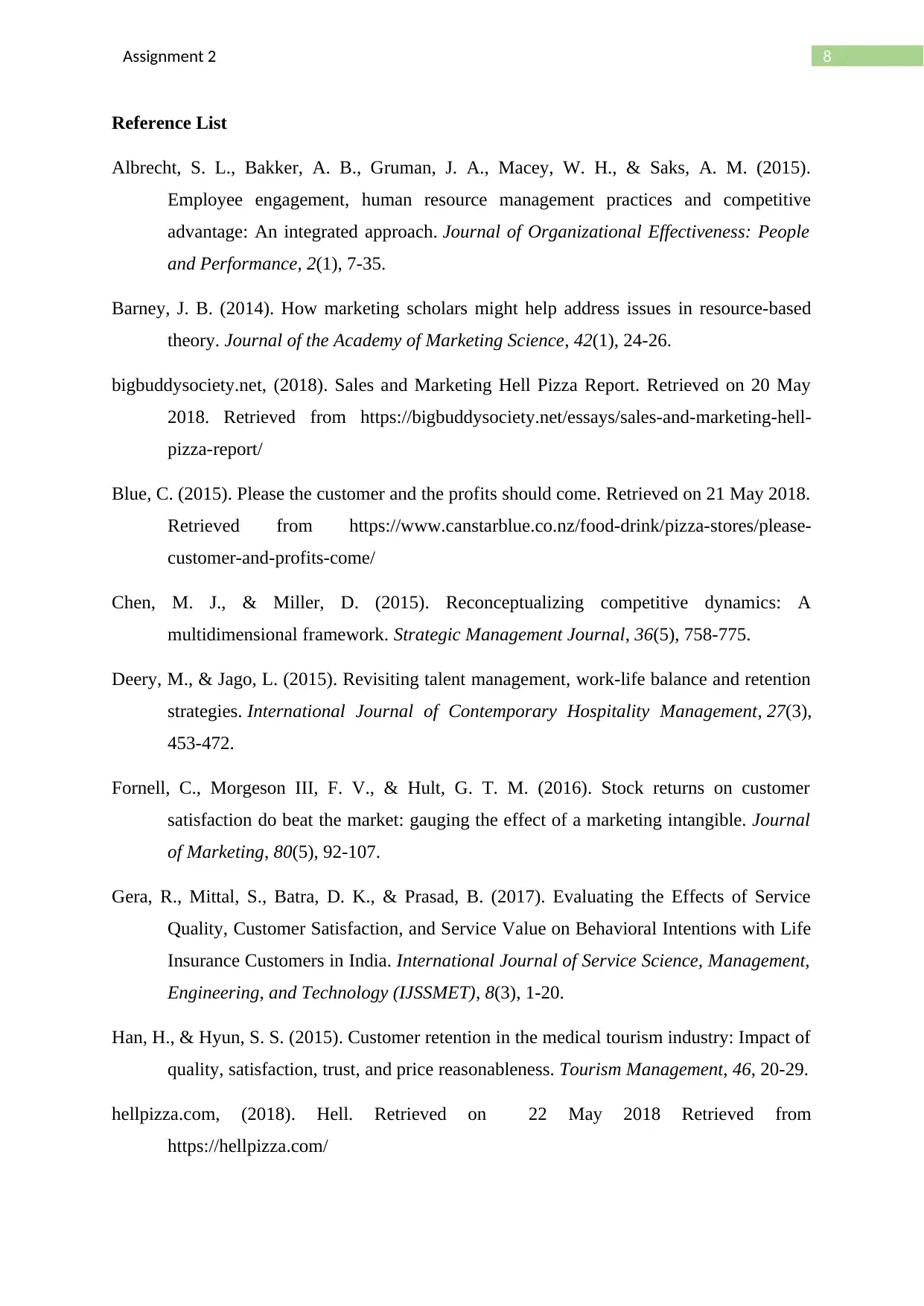
8Assignment 2
Reference List
Albrecht, S. L., Bakker, A. B., Gruman, J. A., Macey, W. H., & Saks, A. M. (2015).
Employee engagement, human resource management practices and competitive
advantage: An integrated approach. Journal of Organizational Effectiveness: People
and Performance, 2(1), 7-35.
Barney, J. B. (2014). How marketing scholars might help address issues in resource-based
theory. Journal of the Academy of Marketing Science, 42(1), 24-26.
bigbuddysociety.net, (2018). Sales and Marketing Hell Pizza Report. Retrieved on 20 May
2018. Retrieved from https://bigbuddysociety.net/essays/sales-and-marketing-hell-
pizza-report/
Blue, C. (2015). Please the customer and the profits should come. Retrieved on 21 May 2018.
Retrieved from https://www.canstarblue.co.nz/food-drink/pizza-stores/please-
customer-and-profits-come/
Chen, M. J., & Miller, D. (2015). Reconceptualizing competitive dynamics: A
multidimensional framework. Strategic Management Journal, 36(5), 758-775.
Deery, M., & Jago, L. (2015). Revisiting talent management, work-life balance and retention
strategies. International Journal of Contemporary Hospitality Management, 27(3),
453-472.
Fornell, C., Morgeson III, F. V., & Hult, G. T. M. (2016). Stock returns on customer
satisfaction do beat the market: gauging the effect of a marketing intangible. Journal
of Marketing, 80(5), 92-107.
Gera, R., Mittal, S., Batra, D. K., & Prasad, B. (2017). Evaluating the Effects of Service
Quality, Customer Satisfaction, and Service Value on Behavioral Intentions with Life
Insurance Customers in India. International Journal of Service Science, Management,
Engineering, and Technology (IJSSMET), 8(3), 1-20.
Han, H., & Hyun, S. S. (2015). Customer retention in the medical tourism industry: Impact of
quality, satisfaction, trust, and price reasonableness. Tourism Management, 46, 20-29.
hellpizza.com, (2018). Hell. Retrieved on 22 May 2018 Retrieved from
https://hellpizza.com/
Reference List
Albrecht, S. L., Bakker, A. B., Gruman, J. A., Macey, W. H., & Saks, A. M. (2015).
Employee engagement, human resource management practices and competitive
advantage: An integrated approach. Journal of Organizational Effectiveness: People
and Performance, 2(1), 7-35.
Barney, J. B. (2014). How marketing scholars might help address issues in resource-based
theory. Journal of the Academy of Marketing Science, 42(1), 24-26.
bigbuddysociety.net, (2018). Sales and Marketing Hell Pizza Report. Retrieved on 20 May
2018. Retrieved from https://bigbuddysociety.net/essays/sales-and-marketing-hell-
pizza-report/
Blue, C. (2015). Please the customer and the profits should come. Retrieved on 21 May 2018.
Retrieved from https://www.canstarblue.co.nz/food-drink/pizza-stores/please-
customer-and-profits-come/
Chen, M. J., & Miller, D. (2015). Reconceptualizing competitive dynamics: A
multidimensional framework. Strategic Management Journal, 36(5), 758-775.
Deery, M., & Jago, L. (2015). Revisiting talent management, work-life balance and retention
strategies. International Journal of Contemporary Hospitality Management, 27(3),
453-472.
Fornell, C., Morgeson III, F. V., & Hult, G. T. M. (2016). Stock returns on customer
satisfaction do beat the market: gauging the effect of a marketing intangible. Journal
of Marketing, 80(5), 92-107.
Gera, R., Mittal, S., Batra, D. K., & Prasad, B. (2017). Evaluating the Effects of Service
Quality, Customer Satisfaction, and Service Value on Behavioral Intentions with Life
Insurance Customers in India. International Journal of Service Science, Management,
Engineering, and Technology (IJSSMET), 8(3), 1-20.
Han, H., & Hyun, S. S. (2015). Customer retention in the medical tourism industry: Impact of
quality, satisfaction, trust, and price reasonableness. Tourism Management, 46, 20-29.
hellpizza.com, (2018). Hell. Retrieved on 22 May 2018 Retrieved from
https://hellpizza.com/

9Assignment 2
Ivanov, G., & Mayorova, E. (2015). Intangible assets and competitive advantage in retail:
case study from Russia. Asian Social Science, 11(12), 38.
Martinaityte, I., Sacramento, C., & Aryee, S. (2016). Delighting the customer: Creativity-
oriented high-performance work systems, frontline employee creative performance,
and customer satisfaction. Journal of Management, 0149206316672532.
Mehta, M. (2014). Scoop.it! Hell Pizza Thin Base - pizza as good as we are bad. Retrieved on
21 May 018. Retrieved from https://www.scoop.it/t/brand-by-manisha-mehta
Porter, M. E., & Kramer, M. R. (2019). Creating shared value. In Managing Sustainable
Business (pp. 327-350). Springer, Dordrecht.
static.hellpizza.com, (2016). Franchise information. Retrieved on 21 May 2018. Retrieved
from https://static.hellpizza.com/web/hell-franchise-info-pack.pdf
stuff.co.nz, (2016). Hell Pizza: The good, the bad and the controversy. StuffNZ. Retrieved on
22 May 2018 Retrieved from https://www.stuff.co.nz/business/78789789/hell-pizza-
the-good-the-bad-and-the-controversy
Ivanov, G., & Mayorova, E. (2015). Intangible assets and competitive advantage in retail:
case study from Russia. Asian Social Science, 11(12), 38.
Martinaityte, I., Sacramento, C., & Aryee, S. (2016). Delighting the customer: Creativity-
oriented high-performance work systems, frontline employee creative performance,
and customer satisfaction. Journal of Management, 0149206316672532.
Mehta, M. (2014). Scoop.it! Hell Pizza Thin Base - pizza as good as we are bad. Retrieved on
21 May 018. Retrieved from https://www.scoop.it/t/brand-by-manisha-mehta
Porter, M. E., & Kramer, M. R. (2019). Creating shared value. In Managing Sustainable
Business (pp. 327-350). Springer, Dordrecht.
static.hellpizza.com, (2016). Franchise information. Retrieved on 21 May 2018. Retrieved
from https://static.hellpizza.com/web/hell-franchise-info-pack.pdf
stuff.co.nz, (2016). Hell Pizza: The good, the bad and the controversy. StuffNZ. Retrieved on
22 May 2018 Retrieved from https://www.stuff.co.nz/business/78789789/hell-pizza-
the-good-the-bad-and-the-controversy
⊘ This is a preview!⊘
Do you want full access?
Subscribe today to unlock all pages.

Trusted by 1+ million students worldwide
1 out of 9
Related Documents
Your All-in-One AI-Powered Toolkit for Academic Success.
+13062052269
info@desklib.com
Available 24*7 on WhatsApp / Email
![[object Object]](/_next/static/media/star-bottom.7253800d.svg)
Unlock your academic potential
Copyright © 2020–2025 A2Z Services. All Rights Reserved. Developed and managed by ZUCOL.




